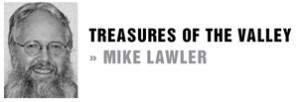Let’s get back to our story on the Verdugo Hills Golf Course and its previous incarnation as WWII enemy alien camp.
Conditions in the camp were good by wartime standards, particularly to a population that was used to Depression era privations. The prisoners were allowed free range of the enclosure, exercise was encouraged, and some, despite their generally short stays, planted gardens or tidied up the compound. But prisoners they were, and no amount of free range or exercise could dull the pain and humiliation of arrest and separation from their families, who themselves were often in the process of being marched off to internment camps minus their fathers or grandfathers left behind the barbed wire of Tuna Camp.
Diasho Tana, who had immigrated to the U.S. in 1928 and had been arrested in March of 1942 in Santa Barbara because he was a Buddhist Priest, wrote his memories of visiting day at Tuna Camp:
“We are prohibited to go within 10 feet of the fence, and it is most painful to be cut off from the outside world. So many families were excited and came here. After 30 minutes of the visit I can see people’s eyes filled with tears [visits were limited to 30 minutes], internees are waving their hands goodbye as the visitors go to the distant parking lot. What can they talk about through the iron fence for 30 minutes? And those who cannot speak English must talk through someone who can understand Japanese [communication through the fence was limited to English].”
The head of the camp, an INS civilian named Mr. Scott, had a high opinion of the Japanese, Germans, Italians, South Americans, and Poles who made up the prisoner population of the camp. He told a minister who visited the Tuna Camp:
“I could open this camp at any time and say, ‘Gentlemen, you may go home to your wives and your families. Come back tomorrow evening by five o’clock.’ They’d go home and have a good time, and they’d all get back by five o’clock, and wouldn’t do any damage while they were out. But I have to have Sarge, an old retired soldier, with a pistol at the gate, and they insisted on building towers with a fellow with a gun on top for these perfectly loyal Americans.”
It sounds like a heartless and unfair situation, and it was, but we must see it through the eyes of the time. One long time local told me that, “It was for their own good” as they needed protection from an inflamed American population.
And indeed there were stories locally of assaults on Asians. I can’t forget the Spencer Tracy movie “Bad Day at Black Rock” in which a Japanese-American, whose son died fighting heroically on the battlefields of Italy, is murdered by small-town vigilantes. That was the mood of America.
But one American saw the injustice and acted on it. Herbert Nicholson, a retired Quaker missionary living in Pasadena, followed his Japanese friends to the internment camps, starting with Tuna Camp, and offered to relay messages, funds, and packages between separated friends and families. He started a free trucking service in and out of Los Angeles, to Manzanar, Poston and Gila River internment camps carrying pets, large valuables, important papers, keys to safe-deposit boxes, and even the ashes of deceased loved-ones. He was a frequent visitor to Tuna Camp.
Nicholson’s wife did service of her own locally for the incarcerated Japanese. Hillcrest Sanitarium, a large tubercular sanitarium located in La Crescenta at the top of Lowell Avenue had been commandeered by the government at the beginning of the war. It was used to treat the Japanese-American internees from all over the western states that had been diagnosed with TB. Mrs. Nicholson spent much of her time with these dying patients.
The Nicolsons’ story is told in a now out of print book from the ‘70s “Valiant Odyssey: Herbert Nicholson In and Out of America’s Concentration Camps” by Weglyn and Mitson.
Mike Lawler is the president of the Historical Society of the
Crescenta Valley. Reach him at lawlerdad@yahoo.com.

